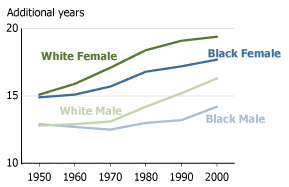
Race, Ethnicity, and Where You Live Matters: Recent Findings on Health and Mortality of U.S. Elderly
(February 2008) Over the past 50 years, remarkable improvements in health care and higher incomes have benefited older Americans from all racial and ethnic groups. But significant gaps persist and have even widened among some groups.
Differences in Health and Life Expectancy
Americans who are 65 years old today can expect to live another 18.4 years on average, approximately four more years than 65-year-olds could have expected 50 years ago. Older Americans also live more of their life disability-free than they did in the past. However, the health advantages gained over the last 50 years have not been the same for all groups.
Among all major racial and ethnic groups, African American elderly fare the poorest with respect to mortality and health.1 The gap in life expectancy between blacks and whites at age 65 grew from close to zero in 1950 to 2.0 years for men and 1.4 years for women in 2004 (see figure). How other groups fare depends partly on the health measure examined, but in general, American Indian elderly tend to have the next poorest health after their African American counterparts. Older Asian and Pacific Islanders fare the best across most of the outcomes examined. Hispanic elderly overall have poorer health but lower mortality than non-Hispanic whites do.
Life Expectancy at Age 65 by Race and Gender, 1950 to 2004

Sources: Centers for Disease Control and Prevention, National Center for Health Statistics, National Vital Statistics System; R.D. Grove and A.M. Hetzel, Vital Statistics Rates in the United States, 1940-1960; and E. Arias, “United States Life Tables, 2004,” National Vital Statistics Report (forthcoming).
Substantial diversity also exists within racial and ethnic groups. For example, among the Hispanic elderly, Puerto Ricans generally have worse health than Cubans and Mexicans. Among Asians and Pacific Islanders, Samoans and Native Hawaiians generally have the worst health.
Hispanics have lower death rates than whites, which presents a paradox because Hispanics generally have lower socioeconomic status than whites. Lower socioeconomic status is usually associated with higher death rates, but not in the case of Hispanics.
There has been much debate about the causes of this “Hispanic Paradox.” Some researchers attribute it to migration effects: Hispanics who migrate to the United States are more likely to be healthy (a selection effect), and the immigrants who return to their home countries are the least healthy (often called, a salmon bias or return migration effect).2 Other researchers argue that the effect is due to cultural factors such as stronger kinship and social support mechanisms in the Hispanic community. These cultural factors may act as a buffer against the effects of disease. Still others argue that the data pointing to this paradox is probably faulty.
Of the studies that examine this paradox closely, many find significant differences among Hispanic subgroups. For instance, a recent study by Alberto Palloni and Elizabeth Arias found that the paradox exists for only foreign-born Hispanics who are not Cuban or Puerto Rican.3 Their study also provides evidence of migration effects: Mexican-born people with poor health opt to return to Mexico at higher rates than healthier Mexican immigrants. In the first study to directly test the selection bias in return migration, Cassio Turra and Irma Elo found that, although this effect exists, it is too small to explain the Hispanic paradox among elderly adults in their study.4
Factors Underlying Racial/Ethnic Health Differences
Complex mechanisms appear to be at the root of racial and ethnic gaps in health. Traditional arguments are that differences in socioeconomic status (SES), in access to health care, and in health behaviors lie behind these racial and ethnic disparities. Researchers generally agree that the main causes include SES, health-risk behavior, psychosocial factors (for example, stress), access to and quality of health care, culture, genetic factors, and environmental and occupational risks. There is no consensus on which factors matter most.
In the United States, people of similar race or ethnicity and similar income are more likely to live in the same areas, so it is difficult to say whether race and ethnicity or place of residence explains racial disparities in health. Recent research suggests that where people live may be an important reason why racial and ethnic disparities persist.
A series of recent studies have found significant geographic differences in health outcomes and health care use within the older population, including the level and quality of care one receives.5 Katherine Baicker and her colleagues find little difference in the quality of care that African Americans and non-Hispanic whites receive from the same provider. But African Americans are more likely to live in parts of the country that have particularly poor service. Consequently, African Americans are also more likely than non-Hispanic whites to experience negative health outcomes.
When geographic effects such as those found by researchers Katherine Baicker, Amitabh Chandra, and Jonathan Skinner are not taken into account, the role race plays in determining disparities may seem larger than it actually is. Baicker and her colleagues suggest that policies aimed at improving the quality of care in underserved regions will benefit all Americans, and in particular racial and ethnic minorities.
Looking Toward the Future
By 2050, the number and the proportion of older adults in the United States are projected to increase substantially. This population is also expected to become much more racially and ethnically diverse than it is today. While the total number of elderly whites ages 65 and older is projected to double, elderly blacks will more than triple in number and the number of elderly Hispanics and other racial minorities will increase eleven fold. The growing number and diversity of U.S. elderly underscore the importance of reducing racial and ethnic health disparities for the nation’s overall health.
Toshiko Kaneda is a policy analyst at the Population Reference Bureau (PRB). Dia Adams was a research assistant at PRB.
References
- Rodolfo A. Bulatao and Norman B. Anderson, eds., Understanding Racial and Ethnic Differences in Health in Late Life (Washington, DC: The National Academies Press, 2004).
- Alberto Palloni and Elizabeth Arias, “Paradox Lost: Explaining the Adult Hispanic Mortality Advantage,” Demography 41, no. 3 (2004): 385-415.
- Palloni and Arias, “Paradox Lost.”
- Cassio Turra and Irma Elo, “The Impact of Salmon Bias on the Hispanic Mortality Advantage: New Evidence from Social Security Data,” Population Research and Policy Review (forthcoming).
- John E. Wennberg, Elliott S. Fisher, and Jonathan S. Skinner, “Geography and the Debate Over Medicare Reform,” Health Affairs (Web exclusive, 2002): W96-114, accessed online at www.healthaffairs.org, on Feb. 20, 2008; Victor Fuchs, Mark McClellan, and Jonathan S. Skinner, “Area Differences in Utilization of Medical Care and Mortality Among U.S. Elderly,” in Perspective on the Economics of Aging, ed. David Wise (Chicago: University of Chicago Press, forthcoming); Amitabh Chandra and Jonathan S. Skinner, “Geography and Racial Health Disparities,” in Critical Perspectives on Racial and Ethnic Differences in Health in Late Life, ed. Norman B. Anderson, Rodolfo A. Bulatao, and Barney Cohen (Washington, DC: National Academies Press, 2004): 604-40; Katherine Baicker et al., “Who You Are and Where You Live: How Race and Geography Affect the Treatment of Medicare Beneficiaries,” Health Affairs (Web exclusive, 2004): VAR33-44, accessed online at www.healthaffairs.org, on Feb. 20, 2008; and Katherine Baicker, Amitabh Chandra, and Jonathan S. Skinner, “Geographic Variation in Health Care and the Problem of Measuring Racial Disparities,” Perspectives in Biology and Medicine 48, no. 1 Supplement (2005): S42-53.






